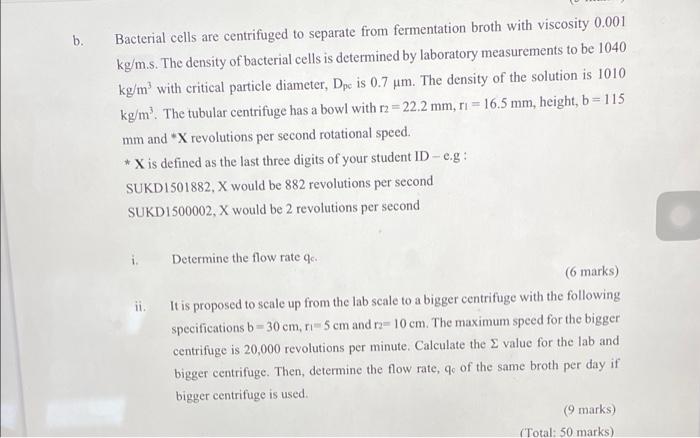Answered step by step
Verified Expert Solution
Question
1 Approved Answer
X=432 b. Bacterial cells are centrifuged to separate from fermentation broth with viscosity 0.001 kg/m.s. The density of bacterial cells is determined by laboratory measurements
X=432 
b. Bacterial cells are centrifuged to separate from fermentation broth with viscosity 0.001 kg/m.s. The density of bacterial cells is determined by laboratory measurements to be 1040 kg/m' with critical particle diameter, Dpe is 0.7 um. The density of the solution is 1010 kg/m?. The tubular centrifuge has a bowl with r2 = 22.2 mm, ri= 16.5 mm, height, b=115 mm and X revolutions per second rotational speed. * X is defined as the last three digits of your student ID-eg: SUKD1501882, X would be 882 revolutions per second SUKD1500002, X would be 2 revolutions per second i. ii Determine the flow rate qe (6 marks) It is proposed to scale up from the lab scale to a bigger centrifuge with the following specifications b = 30cm, 5 cm and r=10 cm. The maximum speed for the bigger centrifuge is 20,000 revolutions per minute. Calculate the value for the lab and bigger centrifuge. Then, determine the flow rate, qe of the same broth per day if bigger centrifuge is used. (9 marks) (Total: 50 marks) 
Step by Step Solution
There are 3 Steps involved in it
Step: 1

Get Instant Access to Expert-Tailored Solutions
See step-by-step solutions with expert insights and AI powered tools for academic success
Step: 2

Step: 3

Ace Your Homework with AI
Get the answers you need in no time with our AI-driven, step-by-step assistance
Get Started


